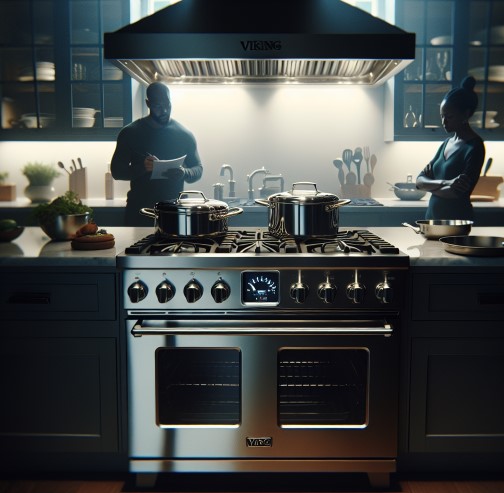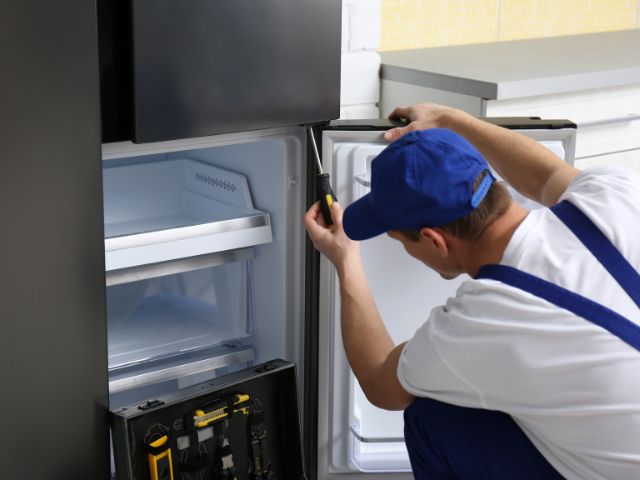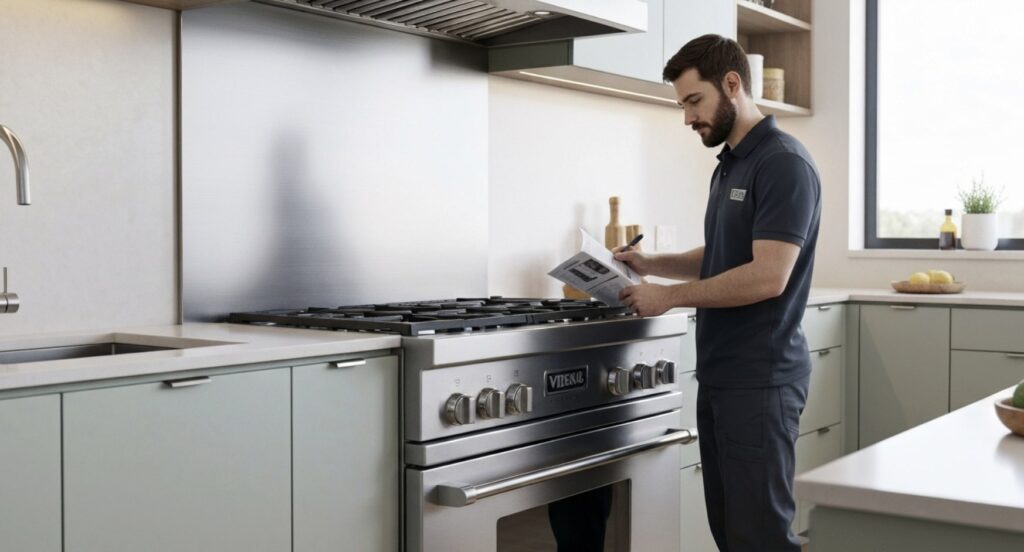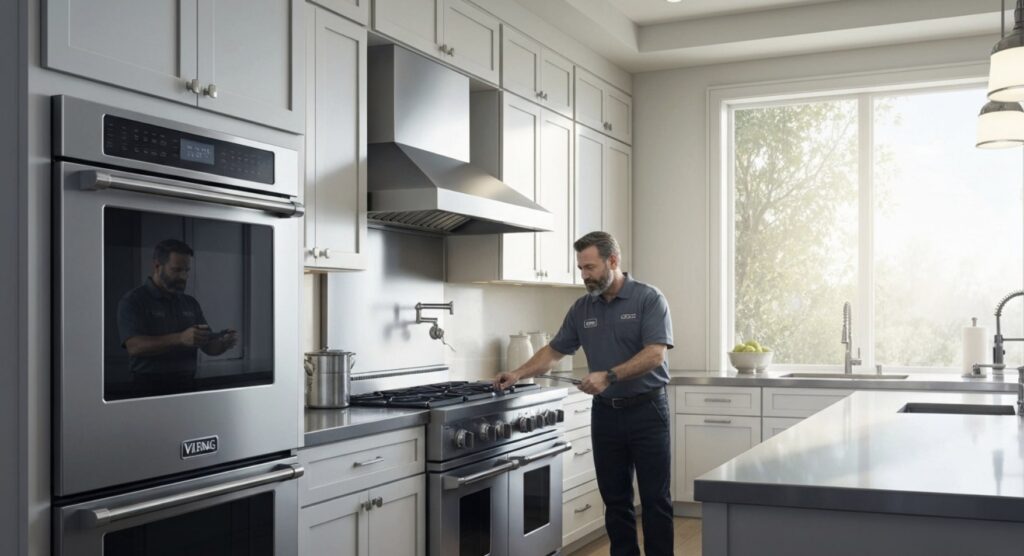A Viking range is a valuable tool for anyone who loves to cook. However, if you have heating issues, it can disrupt your cooking. It is important to know the common reasons for heating problems for proper Viking range repair. This article will discuss the top 10 ways to fix why your Viking range is not heating properly. We aim to help you find a quick solution and get your appliance working well again. We will cover everything about Viking appliance repair and common causes of heating issues.
Top 10 Solutions to Fix Your Viking Range Heating Issues
When your Viking range stops heating, it can cause some kitchen trouble. But before you decide to eat takeout all the time, let’s look at some solutions. There could be problems with the igniters or the thermostat. We will help you figure out what’s wrong with your range’s heating.
With some simple checks and useful tips, you’ll soon be cooking tasty meals again! Let’s take a look at the top 10 solutions for fixing your Viking heating problems:
1. Inspect and Replace Faulty Igniters
A broken igniter can often be the reason why your Viking range won’t heat up. This small part creates the spark to light the gas burners. If you hear clicking but don’t see a flame, or if the flame is weak, your igniter may need fixing.
Start by checking the igniter for any damage, like cracks or burns. If it looks damaged, you need to replace it. Luckily, replacing an igniter is an easy Viking range repair. You can get new igniters made for Viking ranges. Check your range’s manual for directions, or ask a professional appliance repair technician for help.
2. Troubleshoot the Gas Supply for Gas Ranges
For Viking ranges, not having enough gas can cause heating problems. First, make sure the gas valve behind the range is completely open. If it is only partially closed, this can stop enough gas from flowing and lead to low heat.
If the valve is open, there may be a problem with the gas line. Look for any kinks or clogs in the flexible gas line that connects the range to the gas supply. Also, check if the gas supply to your home is working. If you think there is a gas leak or can’t find the problem, turn off the gas supply right away. Then, contact a qualified gas technician or your gas company for Viking appliance repair.
3. Verify and Adjust the Oven’s Thermostat
The thermostat controls the temperature of your oven. If the thermostat isn’t working well, it can cause food to be undercooked or overcooked. You can check if the thermostat needs fixing with some simple steps.
First, preheat your oven to a certain temperature. Then, use an oven thermometer to check the actual temperature inside. If there is a big difference, the thermostat might be the problem. You may need to adjust the thermostat’s settings. If this does not fix it, you might need to replace the thermostat. Look at your oven’s manual or ask a professional for help with the thermostat and heating element repair.
4. Clean or Replace Blocked Burners
Over time, food bits, grease, and dirt can build up on your Viking range’s burners. This can block the gas flow and make heating harder. A clear sign of clogged burners is when the flame looks uneven or it’s hard to light the burner.
The good news is that cleaning the burners is something you can do yourself. Start by taking off the burner grates and caps. Use a soft brush, warm soapy water, and a paperclip or pin to gently clean out any dirt from the burner ports. If the burners are really blocked or damaged, you might need to replace them for better performance. This is an important part of Viking range repair.
5. Check for Electrical Wiring Issues
Electrical problems can cause your Viking range to heat poorly. Loose wires, broken connections, or a bad control board can stop electricity from flowing, making your range unable to heat.
If you think there are issues with the electrical wiring, be careful. Unplug the range from the power before checking the wires. Look for any wear, melting, or loose connections. If you feel uneasy about working with electrical parts, it’s a good idea to contact a licensed electrician or an appliance repair technician who knows about Viking appliance repair.
6. Replace Malfunctioning Heating Elements
For electric Viking ranges, the heating element creates the heat you need. If the heating element is broken, it can cause problems like uneven heating, no heat at all, or hot spots in your oven.
It’s important to check the heating element carefully. Look for any signs of damage like blistering, breaks, or strange colors. If you see any issues, it’s best to replace it. You can find replacement heating elements made for specific Viking range models. Some homeowners can handle this replacement on their own, but it’s usually better to get help from a professional for Viking range repair.
7. Examine the Convection Fan for Obstructions
If you own a Viking range with a convection oven, a broken convection fan can mess up heat flow. This can cause your food to cook unevenly. The convection fan helps spread hot air in the oven for steady temperatures.
Things like loose food bits or dirt can stop the fan from spinning. This makes it hard for the fan to move air well. To check the convection fan, look for it at the back or side of the oven. See if anything is blocking it, and carefully take those things out. If the fan blades are broken or the motor looks damaged, it’s best to call a professional to fix it. This helps keep your appliance working as it should.
8. Reset the Range’s Power Supply
Sometimes, simple solutions can work best. For instance, just like restarting your computer can fix small problems, resetting your Viking range’s power supply can help with heating issues too.
First, turn off the circuit breaker that supplies power to your range. Wait a few minutes to let any leftover power clear out. Then, turn the circuit breaker back on and try to use your range again. This easy step of power cycling can reset the electronic parts and make your Viking range work well again.
9. Replace the Temperature Sensor if Defective
The temperature sensor, which is also called the oven probe, is very important. It watches the oven’s internal temperature and sends that information to the control board. If the temperature sensor is broken, it can give wrong readings. This can cause issues with how the temperature is controlled and impact heating accuracy.
If the temperature sensor is not working right, you might notice strange temperature changes. The oven may not reach the temperature you set, or it could get too hot. If you think your temperature sensor might be faulty, check your range’s manual for testing steps. You can also contact a skilled appliance repair technician for help.
10. Professional Calibration of the Oven
Over time, even the most well-maintained ovens can experience slight calibration drifts. This means the oven’s actual temperature might deviate slightly from the set temperature. While minor variations are generally acceptable, significant calibration issues can affect cooking results. Professional calibration ensures your oven operates within the manufacturer’s intended temperature range, guaranteeing optimal performance and precise heating.
If you’ve ruled out other potential issues and suspect a calibration problem, it’s time to call in the experts. Certified appliance repair technicians possess the necessary tools and expertise to recalibrate your Viking oven, restoring it to factory specifications. This is a key part of Viking appliance repair.
|
Calibration Issue |
Description |
|
Oven temperature too high |
The oven’s temperature is consistently higher than the set temperature. |
|
Oven temperature too low |
The oven’s temperature is consistently lower than the set temperature. |
|
Inconsistent temperature |
The oven’s temperature fluctuates significantly, leading to uneven cooking. |
Conclusion
In conclusion, fixing your Viking range not heating properly needs careful checking and possibly changing any broken parts. You should look at the igniters and have the oven set up by a professional. These fixes will help your range heat up properly again. Taking care of your appliance regularly and quickly fixing any issues can make it last longer. By following these top 10 solutions, you can have smooth cooking experiences with your Viking range. If heating issues keep happening, think about getting a professional to help with deep checks and repairs. For additional insights, check out our blog on A Closer Look at Viking Dual Fuel Ranges.
Frequently Asked Questions
What are the signs of a failing Viking range heating element?
Signs that your heating element is failing are:
- not enough heat
- uneven heating in your oven
- visible damage, like blistering or breakage
- temperatures that are not accurate while cooking
If you see these signs, you might need to consider viking range repair.
Can a power surge cause my Viking range to stop heating?
Yes, a power surge can harm the electrical parts of your viking range. This damage might affect the control board and stop it from heating. To avoid this appliance problem, using a surge protector is a good idea.
Is it safe to replace a Viking range igniter on my own?
Replacing an igniter is something you can do yourself, but safety comes first. Always unplug the power and turn off the gas before you start. If you’re unsure, it’s best to ask a pro for help with your Viking range.







